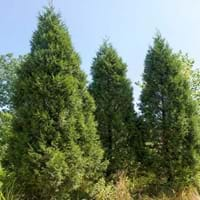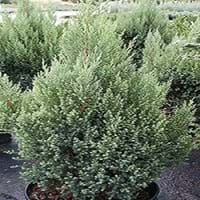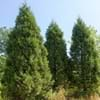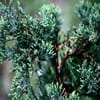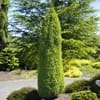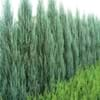Life Span
Perennial
Annual
Type
Needled or Scaled Evergreen
Needled or Scaled Evergreen
Origin
China, Japan
China, Japan
Types
Aurea,Kaizuka,Plumosa Aurea
Juniperus Communis, Juniperus brevifolia, Juniperus brevifolia
Habitat
Deciduous forests, Rocky areas, rocky outcrops
Sandy areas, Well Drained
USDA Hardiness Zone
3-9
3-9
Sunset Zone
1a, 1b, 2a, 2b, 3a, 3b, 4, 5, 6, 7, 8, 9, 10, 11, 12, 13, 14, 15, 16, 17, 18, 19, 20, 21, 22, 23, 24
1a, 1b, 2a, 2b, 3a, 3b, 4, 5, 6, 7, 8, 9, 10, 11, 12, 13, 14, 15, 16, 17, 18, 19, 20, 21, 22, 23, 24
Habit
Upright/Erect
Pyramidal
Flower Color
Light Yellow Green
Not Available
Flower Color Modifier
Bicolor
Bicolor
Fruit Color
Blue Black, Purple Brown
Not Available
Leaf Color in Spring
Green, Blue Green, Gray Green
Green, Blue Green, Gray Green
Leaf Color in Summer
Green, Blue Green, Gray Green
Green, Blue Green, Gray Green
Leaf Color in Fall
Green, Blue Green, Gray Green
Green, Blue Green, Gray Green
Leaf Color in Winter
Green, Blue Green, Gray Green
Green, Blue Green, Gray Green
Leaf Shape
Scale-like imbricate
Needle like
Plant Season
Spring, Summer, Fall, Winter
Spring, Summer, Fall, Winter
Sunlight
Full Sun
Full Sun
Growth Rate
Medium
Medium
Type of Soil
Loam, Sand
Loam, Sand
The pH of Soil
Acidic, Neutral, Alkaline
Acidic, Neutral, Alkaline
Soil Drainage
Well drained
Well drained
Bloom Time
Early Spring, Mid Spring, Spring
Not Available
Tolerances
Drought
Drought
Where to Plant?
Container, Ground, Pot
Container, Ground, Pot
How to Plant?
Cuttings, Seedlings
Rooted stem cutting
Plant Maintenance
Medium
Medium
Watering Requirements
Does not require water in summer, Keep the Soil well drained, Medium
Needs very little water
In Summer
Lots of watering
Lots of watering
In Spring
Moderate
Moderate
In Winter
Average Water
Average Water
Soil pH
Acidic, Neutral, Alkaline
Acidic, Neutral, Alkaline
Soil Type
Loam, Sand
Loam, Sand
Soil Drainage Capacity
Well drained
Well drained
Sun Exposure
Full Sun
Full Sun
Pruning
Remove damaged leaves, Remove dead branches, Remove dead leaves
Prune back the growing tips, Prune if you want to improve plant shape, Remove damaged leaves, Remove dead branches, Remove dead leaves
Fertilizers
All-Purpose Liquid Fertilizer
All-Purpose Liquid Fertilizer, Apply 10-10-10 amount
Pests and Diseases
Scale, Spider mites
Red blotch
Plant Tolerance
Drought
Drought
Flowers
Not Available
None
Flower Petal Number
Single
Single
Foliage Texture
Medium
Medium
Foliage Sheen
Matte
Glossy
Attracts
Not Applicable
Wildlife
Allergy
Not Available
Headache, Itchiness, Pain and fatigue, Pollen, Rhinitis, wheezing
Aesthetic Uses
Bonsai, Hanging Basket, Showy Purposes, Used for decorating walls, fences, gates, hedges, etc.
Borders, Showy Purposes
Beauty Benefits
Not Available
Not Available
Environmental Uses
Air purification
Air purification
Medicinal Uses
Antirheumatic, Hemostatic, Hepatic, Skin Diseases, Skin wounds, treating tumours
Antibacterial, Arthritis, Eczema, Psoriasis, Rheumatism, Snakebite
Part of Plant Used
Flowers, Leaves, Root, Stem
Not Available
Other Uses
Decoration Purposes, Pesticide, Used as Ornamental plant
Used as essential oil
Used As Indoor Plant
No
No
Used As Outdoor Plant
Yes
Yes
Garden Design
Container, Edging, Feature Plant, Foundation, Groundcover, Hedges, Mixed Border, Topiary, Bonsai, Espalier
Feature Plant, Foundation, Hedges, Mixed Border, Screening, Wind Break, Topiary, Bonsai, Espalier
Botanical Name
JUNIPERUS chinensis
JUNIPERUS chinensis 'Blue Point'
Common Name
Chinese Juniper
Blue point juniper
In Hindi
चीनी जुनिपर
Blue point juniper tree
In German
chinesische Wacholder
Blauer Punkt Wacholder
In French
genévrier de Chine
Point bleu genévrier
In Spanish
enebro chino
enebro punto azul
In Greek
Κινέζικα αρκεύθου
δέντρο αρκεύθου μπλε σημείο
In Portuguese
zimbro chinês
zimbro do ponto azul
In Polish
jałowiec chiński
Niebieski punkt drzewa jałowca
In Latin
Chinese iuniperorum
Blue Point juniperi:
Phylum
Pinophyta
Pinophyta
Class
Pinopsida
Pinopsida
Family
Cupressaceae
Cupressaceae
Genus
Juniperus
Juniperus
Clade
Not Available
Not Available
Tribe
Not Available
Not Available
Subfamily
Cupressoideae
Not Applicable
Season and Care of Chinese Juniper and Blue Point Juniper
Season and care of Chinese Juniper and Blue Point Juniper is important to know. While considering everything about Chinese Juniper and Blue Point Juniper Care, growing season is an essential factor. Chinese Juniper season is Spring, Summer, Fall and Winter and Blue Point Juniper season is Spring, Summer, Fall and Winter. The type of soil for Chinese Juniper is Loam, Sand and for Blue Point Juniper is Loam, Sand while the PH of soil for Chinese Juniper is Acidic, Neutral, Alkaline and for Blue Point Juniper is Acidic, Neutral, Alkaline.
Chinese Juniper and Blue Point Juniper Physical Information
Chinese Juniper and Blue Point Juniper physical information is very important for comparison. Chinese Juniper height is 60.00 cm and width 180.00 cm whereas Blue Point Juniper height is 365.76 cm and width 243.84 cm. The color specification of Chinese Juniper and Blue Point Juniper are as follows:
Chinese Juniper flower color: Light Yellow Green
Chinese Juniper leaf color: Green, Blue Green and Gray Green
Blue Point Juniper flower color: Not Available
- Blue Point Juniper leaf color: Green, Blue Green and Gray Green
Care of Chinese Juniper and Blue Point Juniper
Care of Chinese Juniper and Blue Point Juniper include pruning, fertilizers, watering etc. Chinese Juniper pruning is done Remove damaged leaves, Remove dead branches and Remove dead leaves and Blue Point Juniper pruning is done Prune back the growing tips, Prune if you want to improve plant shape, Remove damaged leaves, Remove dead branches and Remove dead leaves. In summer Chinese Juniper needs Lots of watering and in winter, it needs Average Water. Whereas, in summer Blue Point Juniper needs Lots of watering and in winter, it needs Average Water.
